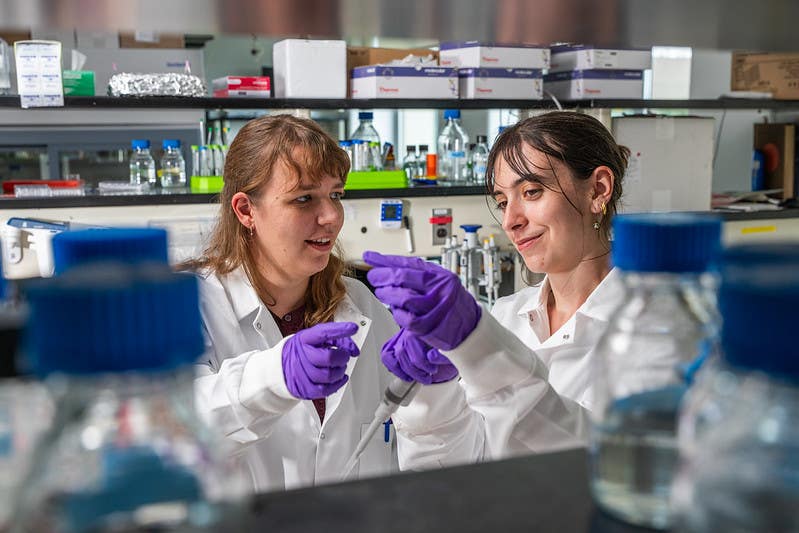New enzyme discovery could transform male birth control
New research reveals how sperm flip a metabolic switch to power their final sprint toward fertilization.

In the Balbach lab, researchers like graduate student Macy Jenks (R) are helping push the boundaries of reproductive metabolism. (CREDIT: Finn Gomez & Paul Henderson / MSU College of Natural Science)
Researchers have discovered how sperm cells perform an extraordinary metabolic transformation after ejaculation, from quiet storage mode to full-speed motion in their mission to fertilize an egg.
In a study by Michigan State University, researchers mapped how mammalian sperm rapidly reprogram their energy equipment. They discovered an enzyme that acts as a molecular “switch” to fuel high-speed movement.
A Dramatic Shift in Energy Policy
Before ejaculation, sperm reside in the epididymis at low energy levels, conserving fuel while in storage. Upon release, they face a strenuous journey through the female's reproductive tract. To survive, they must swim forcefully, undergo chemical modification of their membrane, and practice penetration of an egg.
This transformation—capacitation—redesigns the metabolism of the sperm. As it does so, sperm shift from a balanced, consistent fueling to a rapid, high-energy state that propels their whip-like tails. Researchers discovered that this rapid burst of energy is produced from a highly condensed glycolytic process. In this process, glucose is broken down to generate energy in the form of ATP.
The surprise came with the discovery by scientists that a key enzyme, aldolase, rather than the previously long-standing phosphofructokinase (PFK), controls this metabolic peak. Aldolase rises spectaculously during capacitation, turning sperm into teeny-tiny engines for rapid response.
Aldolase: The Surprising Power Regulator
"Sperm metabolism is special in that it's specially committed to making more energy to do just one thing: fertilization," said Melanie Balbach, assistant professor in Michigan State University's Department of Biochemistry and Molecular Biology and senior author on the study.
Balbach and her team discovered that aldolase is a checkpoint for the flow of glucose along the pipeline of energy. By regulating the rate at which glucose passes through glycolysis, the enzyme determines how much energy the sperm can generate. Sperm are transcriptionally inert, as opposed to the majority of other cells, which prevents them from generating new enzymes when their environment is altered. That makes the switching on of aldolase without fresh protein synthesis especially significant.
The study also found that the activation of aldolase is regulated by a signal pathway driven by soluble adenylyl cyclase (sAC). This calcium- and bicarbonate-perceptive enzyme is present during capacitation. When this signal is blocked, sperm are unable to increase their glycolytic rate, making them slow and less fertile.
Tracing Fuel in Real Time
To watch where sperm burn fuel, Balbach's team followed the chemical trail of glucose molecules within the cell. "You can think of this technique as painting a car's roof hot pink and then following that car around through traffic using a drone," Balbach said. "In live sperm, we were able to watch that painted car zip through traffic much faster while taking a particular route and even watch which intersections the car would become stuck at."
Tracing tagged glucose molecules, researchers were able to see how sperm switch from protection to high-power mode. Before ejaculation, sperm employ the pentose phosphate pathway (PPP) to protect themselves from damage rather than energy production. After ejaculation, they redirect their metabolism through glycolysis in favor of rapid energy production over long-term protection.
Sperm structure is best suited for this role. The midpiece near the head holds mitochondria that generate steady, sustained energy through oxidative phosphorylation. The longer principal piece of the tail holds glycolytic enzymes. Longer pieces allow sperm to make transient bursts of power as well as sustained power—similar to a hybrid car shifting from battery to fueling mode depending on use.
The study found that most of the pyruvate sperm use to fuel this process is stored internally, rather than being tapped from external stores. This internal reserve enables sperm to keep moving even in situations of low external fuel levels. Sperm deplete these stores within a matter of minutes of capacitation. It is probable that they also employ other internal reservoirs like fatty acids or glutamine as backup fuel.
Lactate: Waste or Messenger
One fascinating fact is that lactate, a byproduct of glycolysis, is usually recycled by most cells to yield energy, but sperm apparently release it. This keeps the right internal environment so motility can continue by stopping acid buildup inside the cell.
Curiously, scientists think that lactate may also be used as a means of communication. Some evidence suggests that it may inhibit immune function in the female reproductive tract, protecting sperm on their journey—just like cancer cells use lactate to render themselves immune-evasive.
To validate their findings, the researchers measured enzyme activity in resting and activated sperm using commercial assays. Statistical analysis confirmed that aldolase activity and glycolytic throughput greatly increased during capacitation, validating its critical role in energy management. The data, analyzed with GraphPad Prism software, showed highly significant differences with p-values much smaller than 0.001.
Opening Doors to Fertility Treatments and Birth Control
Understanding sperm's regulation of metabolism has broad implications. Infertility often has its root in the insufficiency of sperm motility, and glycolytic enzyme abnormalities like aldolase may be one reason. Or the regulation of this enzyme could provide a basis for a novel nonhormonal method of male contraception.
As a postdoctoral researcher at Weill Cornell Medicine, Balbach helped show that blocking a central sperm enzyme temporarily made mice sterile—not with hormones or permanent damage. Her research now expands on such findings, asking if attacking sperm metabolism could yield an "on-demand" male contraceptive with more equitable reproduction choices.
"Today, approximately 50% of all pregnancies are unplanned, and this would give men additional options and control over their fertility," Balbach said. "It gives women birth control users freedom as well, which is hormonal and highly vulnerable to side effects."
A Broader View of Cellular Adaptation
This study not only expands sperm biology knowledge but also provides insight into how cells adapt when they cannot create new proteins. Even without gene expression, sperm are incredibly flexible, rearranging their existing molecules in order to fit new energy demands.
As scientists become more familiar with how these molecular "traffic cops" work, they are hoping to discover safe ways to regulate energy use in sperm and possibly other cells that work on related metabolic shell games.
Practical Applications of the Research
The discovery of aldolase's central role promises both promising directions in fertility enhancement and birth control. For fertility therapy, the discovery of enzyme malfunctions could improve treatment of couples with conception problems.
In contraceptives, blocking aldolase or enzymes like it could yield reversible, nonhormonal methods that cause minimal side effects and give men more options.
Beyond reproduction, this research could lead to new ways to study metabolism in cells that have lost the capacity for synthesizing new proteins, further understanding the way energy is controlled in biology.
Research findings are available online in the journal PNAS.
Related Stories
- Men's role in reproduction could soon become obsolete
- Blood sugar is key to men’s reproductive health, study finds
- This ancient species has existed for 10 million years without sexual reproduction
Like these kind of feel good stories? Get The Brighter Side of News' newsletter.
Joseph Shavit
Science News Writer, Editor-At-Large and Publisher
Joseph Shavit, based in Los Angeles, is a seasoned science journalist, editor and co-founder of The Brighter Side of News, where he transforms complex discoveries into clear, engaging stories for general readers. With experience at major media groups like Times Mirror and Tribune, he writes with both authority and curiosity. His work spans astronomy, physics, quantum mechanics, climate change, artificial intelligence, health, and medicine. Known for linking breakthroughs to real-world markets, he highlights how research transitions into products and industries that shape daily life.



